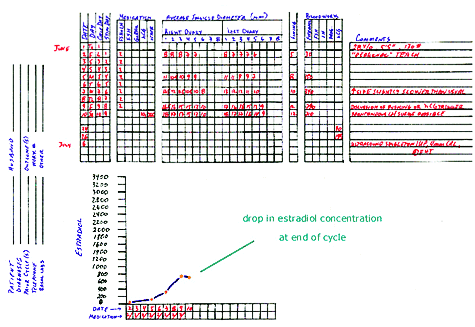|
Controlled Ovarian Hyperstimulation: Pergonal #3

This (successful) cycle of controlled ovarian hyperstimulation (COH) with intrauterine insemination (IUI) illustrates the progress that often occurs during COH cycles. Comments about this particular cycle might include:
1. A standard dose of menotropins (2 ampules a day) was begun on cycle day 2. After 3 days of menotropins, the estradiol concentration was 150 pg/mL and the lead follicles were 10-11 mm diameter. This is a normal response so the dose of menotropin was not changed
2. After the 5th day of stimulation the estradiol increased normally yet the ovarian follicular diameters were increasing a bit slower than usual. The decision was to give the same dose of menotropins and check the progress in 2 days.
3. After the 7th day of stimulation, the estradiol concentrations and follicular diameters were increasing nicely. Estradiol concentrations are often in the ballpark of 100-200 pg/mL per “mature” follicle, this patient’s estradiol was not very high given the number of follicles seen on ultrasound, so we discussed the option of pushing (stimulating growth) for one more day versus triggering ovulation. We decided to give one more day of menotropins
4. After the 8th day of menotropins, the estradiol concentration actually decreased from 790 pg/mL to 710 pg/mL. This usually reflects that the patient has triggered ovulation with her own LH surge (which is possible if she is not on a GnRH agonist like lupron). When ovulation is triggered, the subsequent day’s estradiol concentration (generally) falls (prior to the actual release of the eggs). In this specific situation, we discussed and decided on “retriggering” ovulation with hCG (to be certain that the eggs were triggered to ovulate at least once, knowing that if the ovaries were triggered twice that this would not disrupt the ovulation process).
5. The patient had intercourse on 6/11/00 (to keep sperm available if the eggs were to be released earlier than expected due to a possible LH surge) and we performed an intrauterine insemination on 6/12/00.
6. The positive hCG titer was normal 2 weeks after triggering ovulation and rose normally. The ultrasound at 6 weeks gestation (4 weeks after ovulation) revealed a viable singleton intrauterine pregnancy.
Additional Case Studies: COH Cycle 1 | COH Cycle 2
| COH Cycle 3
| COH Cycle 4 | COH Cycle 5
|

|